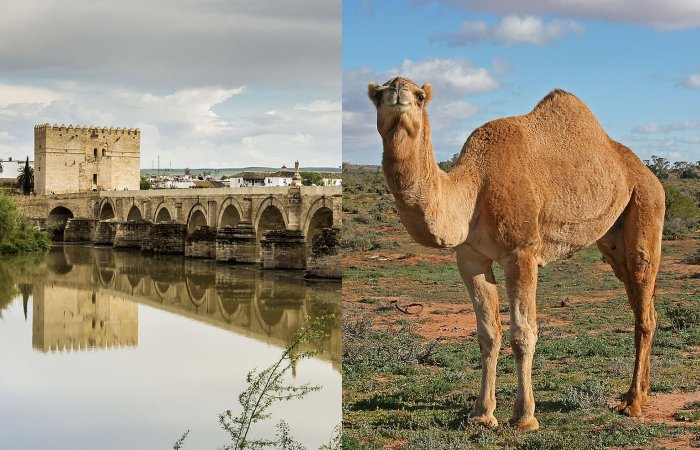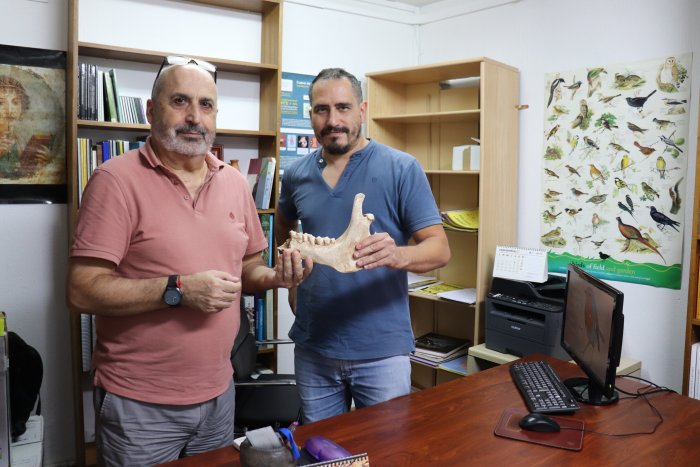Jan Bartek – AncientPages.com – A research team has found the remains of nine different camelids, making Córdoba one of the main sites featuring this animal on the Iberian Peninsula.
Although different sources spoke of the presence of camelids in the province of Córdoba during the al-Andalus period, skeletal remains of this species had never been identified in the capital—until now.

Left: Roman bridge of Córdoba. Credit: Rafesmar – CC BY-SA 4.0. Right: Dromedary camel. Credit: Jjron – CC BY-SA 3.0
After analyzing more than 150,000 specimens kept at the Provincial Archaeological Museum of Córdoba, the UCO’s Research Group on Heritage Resources, together with the CSIC-Granada, the UNED, and the University of Granada, located and identified the remains of nine camelids in the city and two others in Medina Azahara, making Córdoba “the site on the Iberian Peninsula where the presence of camelids is clearest in terms of the number of remains,” stated UCO researcher José Antonio Riquelme Cantal.
Moreover, they were not exclusive to the al-Andalus period, but also corresponded to the Roman era, when there was no evidence of camelids in Cordoba.
In this way, the study managed to fill a gap in the history of Cordoba’s fauna “corroborating what al-Andalus sources said about the existence of camelids in the city, and confirming their presence during the Roman Empire, something that was not known,” explained Riquelme Cantal.
As on other parts of the Peninsula, the Romans brought camelids to Cordoba, but it was with the arrival of the Muslims that they became more numerous, demonstrated by the fact that most of the remains found correspond to the al-Andalus era, when camelids were imported from North Africa to serve as transport on military campaigns, so their number increased significantly.
The remains of the eleven camelids found have been the focus of different studies to obtain the maximum amount of information from them. Comparing them with the morphological characteristics of current specimens made it possible to identify them as camelids. Future studies, the research team says, will explore the possibility that during the Roman era, due to the vast scope of the Empire, there were also two-humped camels from Asia.
Thanks to carbon-14 dating, four sets of remains were dated in a more specific way. The rest could not be dated using this method due to insufficient information. Finally, the analysis of stable isotopes—that is, those that are not radioactive and remain unchanged over time—made it possible to determine the camelids’ geographical location.
Specifically, stable carbon isotopes are related to feeding on plants, typical of herbivorous animals like camelids. The type of plant they ate is, thus, recorded in these isotopes. As some plants only grow in a few areas, the study has concluded that some camelids were highly mobile, proceeding from other provinces of the Roman Empire, or from North Africa in medieval times.

The researchers José Antonio Riquelme Cantal y Juan Manuel Garrido Anguita with a camelid bone. Credit: University of Cordoba
Analysis of the skeletal remains and the place where they were found has also yielded information about their utility and importance in each era. Although during the Roman period the bones were placed in the Palace of Cercadilla, or to a craft workshop where animal bones were used to create objects, in the al-Andalus period the camelids were located on the outskirts of the city, which suggests that it may have already been a more common animal, as it was in the Arab and North African countries.
See also: More Archaeology News
Regarding their use, the study, which was published in the Journal of Archaeological Science: Reports, concludes that they were animals mainly used to transport goods, and that their bones were used to make instruments like tools and decorative elements. In the time of the Caliphate they were imported from North Africa as cargo animals to be used in wars against the Christian kingdoms.
Written by Conny Waters – AncientPages.com Staff Writer





